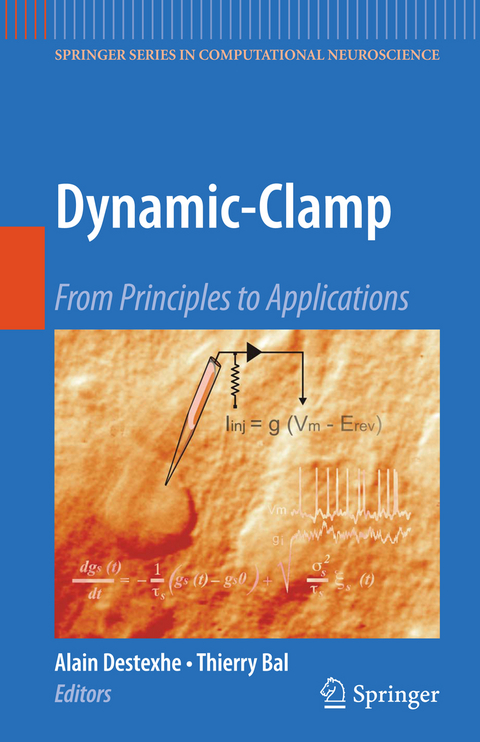
Dynamic-Clamp
Springer-Verlag New York Inc.
978-1-4419-2790-3 (ISBN)
Dynamic-clamp is a fascinating electrophysiology technique that consists of merging living neurons with computational models. The dynamic-clamp (also called “conductance injection”) allows experimentalists and theoreticians to challenge neurons (or any other type of cell) with complex conductance stimuli generated by a computer.
The technique can be implemented from neural simulation environments and a variety of custom-made or commercial systems. The real-time interaction between the computer and cell also enables the design of recording paradigms with unprecedented accuracy via a computational model of the electrode. Dynamic-Clamp: From Principles to Applications contains contributions from leading researchers in the field, who investigate these paradigms at the cellular or network level, in vivo and in vitro, and in different brain regions and cardiac cells. Topics discussed include the addition of artificially-generated synaptic activity to neurons; adding, amplifying or neutralizing voltage-dependent conductances; creating hybrid networks with real and artificial cells; attaching simulated dendritic tree structures to the living cell; and connecting different neurons.
This book will be of interest to experimental biophysicists, neurophysiologists, and cardiac physiologists, as well as theoreticians, engineers, and computational neuroscientists. Graduate and undergraduate students will also find up-to-date coverage of physiological problems and how they are investigated.
Dr. Alain Destexhe and Dr.Thierry Bal, are Research Directors at the Centre National de la Recherche Scientifique (CNRS), a governmental research institution in France. Their laboratories are located in the CNRS campus of Gif-sur-Yvette in the research unit (Unité de Neurosciences Intégratives et Computationnelles, UNIC). Gif-sur-Yvette is solely devoted to research and provides an ideal environment for close interaction between theory and experiments, as exemplified by the numerous publications on dynamic-clamp experiments co-authored by Bal and Destexhe. Each editor holds Ph.D.s in both biophysics and neurobiology, respectively. Dr. Destexhe is also Chief Editor of the Journal of Computational Neuroscience.
Associating Living Cells and Computational Models: an Introduction to Dynamic Clamp Principles and its Applications.- Dendritic Dynamic Clamp – A Tool to Study Single Neuron Computation.- Synaptic Conductances and Spike Generation in Cortical Cells.- Simulating In Vivo Background Activity in a Slice with the Dynamic Clamp.- Impact of Background Synaptic Activity on Neuronal Response Properties Revealed by Stepwise Replication of In Vivo-Like Conditions In Vitro.- Testing Methods for Synaptic Conductance Analysis Using Controlled Conductance Injection with Dynamic Clamp.- In Vivo Dynamic-Clamp Manipulation of Extrinsic and Intrinsic Conductances: Functional Roles of Shunting Inhibition and I BK in Rat and Cat Cortex.- Functions of the Persistent Na+ Current in Cortical Neurons Revealed by Dynamic Clamp.- Using “Hard” Real-Time Dynamic Clamp to Study Cellular and Network Mechanisms of Synchronization in the Hippocampal Formation.- Unraveling the Dynamics of Deep Cerebellar Nucleus Neurons with the Application of Artificial Conductances.- Intrinsic and Network Contributions to Reverberatory Activity: Reactive Clamp and Modeling Studies.- Dynamic-Clamp-Constructed Hybrid Circuits for the Study of Synchronization Phenomena in Networks of Bursting Neurons.- Using the Dynamic Clamp to Explore the Relationship Between Intrinsic Activity and Network Dynamics.- Re-Creating In Vivo-Like Activity and Investigating the Signal Transfer Capabilities of Neurons: Dynamic-Clamp Applications Using Real-Time Neuron.- Using the Dynamic Clamp to Dissect the Properties and Mechanisms of Intrinsic Thalamic Oscillations.- Dynamic Clamp with High-Resistance Electrodes Using Active Electrode Compensation In Vitro and In Vivo.- Key Factors for Improving Dynamic-Clamp Performance.-Development of a Genetically Engineered Cardiac Pacemaker: Insights from Dynamic Action Potential Clamp Experiments.
| Erscheint lt. Verlag | 5.11.2010 |
|---|---|
| Reihe/Serie | Springer Series in Computational Neuroscience ; 1 |
| Zusatzinfo | 60 Illustrations, black and white; XIV, 429 p. 60 illus. |
| Verlagsort | New York, NY |
| Sprache | englisch |
| Maße | 155 x 235 mm |
| Themenwelt | Informatik ► Weitere Themen ► Bioinformatik |
| Medizin / Pharmazie ► Medizinische Fachgebiete ► Neurologie | |
| Medizin / Pharmazie ► Studium | |
| Naturwissenschaften ► Biologie ► Humanbiologie | |
| Naturwissenschaften ► Biologie ► Zoologie | |
| ISBN-10 | 1-4419-2790-5 / 1441927905 |
| ISBN-13 | 978-1-4419-2790-3 / 9781441927903 |
| Zustand | Neuware |
| Haben Sie eine Frage zum Produkt? |
aus dem Bereich


